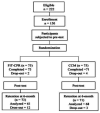Fit-cardiopulmonary resuscitation approach in public mass cardiopulmonary resuscitation teaching: A randomized control trial
- PMID: 37182912
- PMCID: PMC10187741
- DOI: 10.15537/smj.2023.44.5.20220941
Fit-cardiopulmonary resuscitation approach in public mass cardiopulmonary resuscitation teaching: A randomized control trial
Abstract
Objectives: To improve public awareness and the rate of bystander cardiopulmonary resuscitation (CPR), a novel and exciting approach called fit-CPR that incorporates mass CPR with high-intensity physical activity into the beat of locally favoured music was proposed. This study was conducted to measure the effectiveness of fit-CPR compared to the standard classroom method (CCM).
Methods: Between 30th August to 29th November 2018, 129 participants from Syiah Kuala University, Banda Aceh, Indonesia, were randomized to learn CPR, either through fit-CPR or CCM protocol. All participants underwent pre, post, and 6-month retention tests. Each test had a 10-item questionnaire with CPR performance on a manikin that was assessed using a validated checklist.
Results: Sixty-one (47.3%) participants completed the fit-CPR while 68 (52.7%) completed the CCM. There was a significant improvement in knowledge, performance, and quality of CPR from pre, post, and 6-month retention tests (p<0.01) in both groups. On high-quality CPR, the fit-CPR and CCM groups obtained an increased score of 285.0% and 151%, respectively, p=0.014 between pre and immediate post-test. Knowledge scores between fit-CPR and CCM groups showed an increase of 79.5% and 111.2%, respectively, p=0.002. Fit-CPR was completed between 52.5-57.5 minutes, while CCM took 75 minutes.
Conclusion: The fit-CPR demonstrated a comparable outcome to standard CPR when teaching to the mass public with less time spent.
Keywords: cardiopulmonary resuscitation; exercise; learning; out-of-hospital cardiac arrest; simulation training.
Copyright: © Saudi Medical Journal.
Figures



References
-
- Hasselqvist-Ax I, Riva G, Herlitz J, Rosenqvist M, Hollenberg J, Nordberg P, et al. . Early cardiopulmonary resuscitation in out-of-hospital cardiac arrest. N Engl J Med. 2015; 372: 2307–2315. - PubMed
-
- Kragholm K, Wissenberg M, Mortensen RN, Hansen SM, Malta Hansen C, Thorsteinsson K, et al. . Bystander efforts and 1-year outcomes in out-of-hospital cardiac arrest. N Engl J Med 2017; 376: 1737–1747. - PubMed
-
- Rihiantoro T, Purbianto, Amatiria G , Suarnid L. Community Preparedness of Laypeople in Doing Cardiac Pulmonary Resuscitation (CPR) on Cardiac Arrest Victims. International Journal of Innovation, Creativity and Change. 2020; Special Edition (Safe Communities).
-
- Tanaka H, Ong MEH, Siddiqui FJ, Ma MHM, Kaneko H, Lee KW, et al. . Modifiable Factors Associated With Survival After Out-of-Hospital Cardiac Arrest in the Pan-Asian Resuscitation Outcomes Study. Ann Emerg Med 2018; 71: 608–617 - PubMed
-
- Swor R, Khan I, Domeier R, Honeycutt L, Chu K, Compton S. CPR training and CPR performance: do CPR-trained bystanders perform CPR? Acad Emerg Med 2006; 13: 596–601. - PubMed
Publication types
MeSH terms
LinkOut - more resources
Full Text Sources
Medical

